May 17, 2023 | All, Science
17/05/2023 – These bursts, which show a similar luminosity in almost all cases, are used to measure distances in the universe or to study dark energy. The study, in which the Institute de Astrophysics de Andalusia (IAA-CSIC) participates, shows that the explosion occurred in a double star system in which a white dwarf stole material from its solar-type companion. El trabajo, en el que participa el Instituto de Astrofísica de Andalucía (IAA-CSIC), muestra que la explosión se produjo en un sistema doble de estrellas en el que una enana blanca robaba material de su compañera, de tipo solar.
Type Ia supernovae are produced when a white dwarf, the "corpse" of a Sun-like star, absorbs material from a companion star and reaches a critical mass, equivalent to 1.4 solar masses, triggering an explosion whose luminosity will, given its origin, be similar in almost all cases. This uniformity made Type Ia supernovae the ideal objects for measuring distances in the Universe, but the origin and nature of the progenitor system was unknown. Now, the first radio observation of a type Ia supernova confirms that it comes from a double star system consisting of a white dwarf and a solar-type star. The results are published in the journal Nature.
"When we saw signs of a strong interaction with the companion star material in supernova SN2020eyj, we tried to observe the explosion in radio, something that had been attempted without success for decades", explains Erik Kool, a researcher at Stockholm University and lead author of the paper.
Type Ia supernovae always contain a white dwarf, which receives material from its companion. However, it was not known whether this companion was a white dwarf or a Sun-like star, something that radio imaging could reveal.
“This first radio detection of a type Ia supernova is a milestone that has allowed us to demonstrate that the exploded white dwarf was accompanied by a normal, non-degenerate star before the explosion", says Javier Moldón, a researcher at the IAA-CSIC who participated in the discovery. In addition, with these observations we can estimate the mass and geometry of the material surrounding the supernova, which allows us to better understand what the system was like before the explosion.
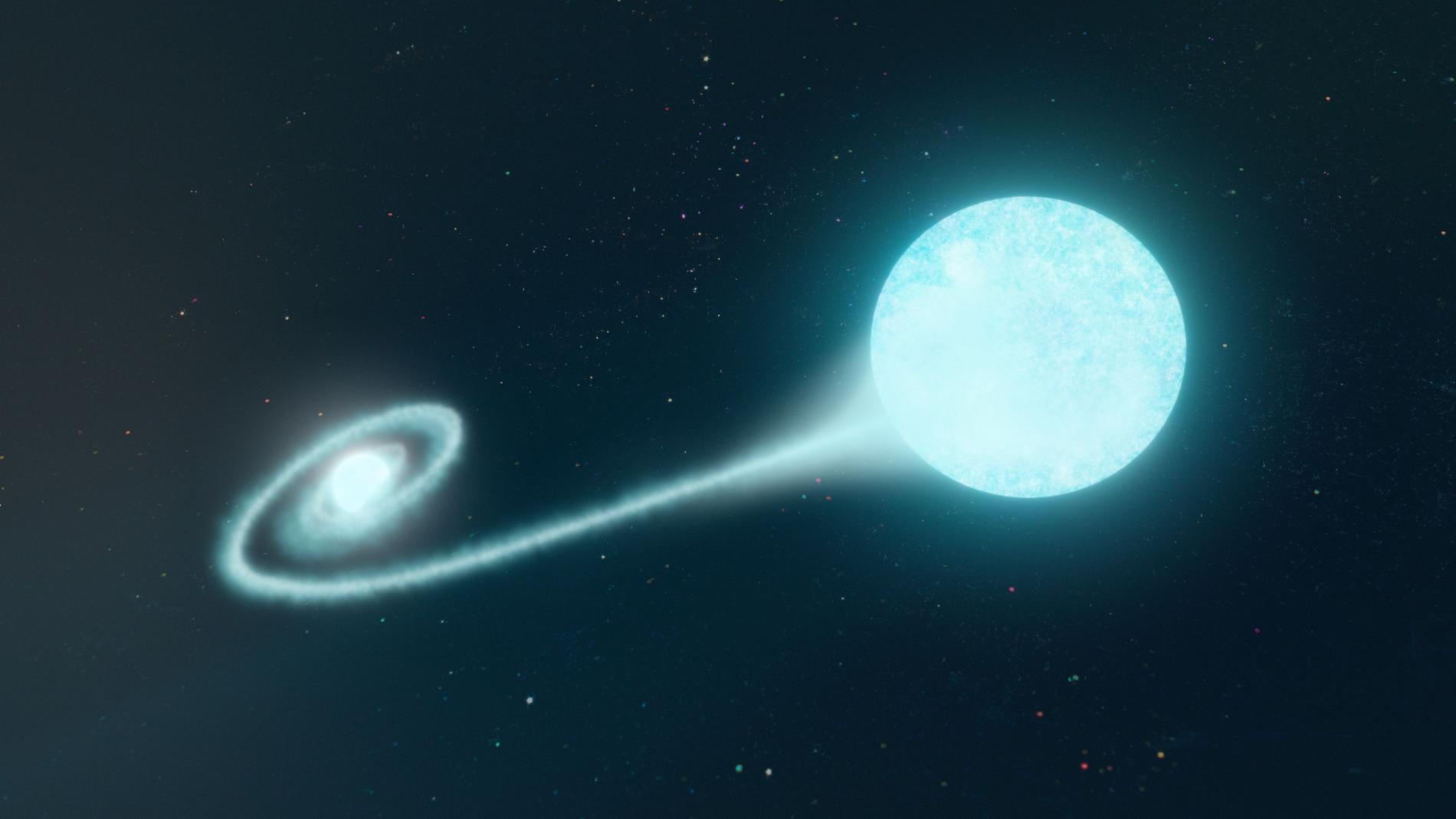
Artist's conception of the system that produced the supernova, in which a white dwarf star absorbs material from its companion star. Source: Adam Makarenko/W. M. Keck Observatory.
This work, whose contribution in radio data was led by the IAA-CSIC, has confirmed that the material expelled in the supernova explosion collided, after travelling sixty days, with the material surrounding the system, composed mostly of helium, which indicates that the companion star was not a white dwarf. Furthermore, models predicted that the radio emission, if present, would take many months to be detectable, and indeed the science team had to wait a year and a half to detect the supernova's radio counterpart.
“The unusual light curve of SN 2020eyj, the infrared emission, the detection of helium emission lines and the unprecedented radio detection make this supernova unique, a treasure of information with implications for multiple fields of research", says Miguel Pérez Torres, an IAA-CSIC researcher participating in the study. “Studying more similar systems will allow us to better understand the origin of these standard candles and the chemical evolution of galaxies”.
"Now that we have shown that radio observations can provide direct and unique information to understand this type of supernovae, it opens a path to study these systems with the new generation of radio instruments, such as the Square Kilometre Array Observatory (SKAO) in the future", concludes Javier Moldón (IAA-CSIC).
The result has been possible thanks to e-MERLIN, an array of very high angular resolution radio telescopes, and the analysis of the data has been carried out from the Spanish prototype of the SKA Regional Centre (SPSRC) of the IAA-CSIC, which is supported by the Severo Ochoa project of the IAA and which facilitates the processing of data from SKAO pathfinders, such as e-MERLIN.
[/et_pb_text][/et_pb_column] [/et_pb_row] [/et_pb_section]
Dec 13, 2022 | All, Science
13/12/2022 – The Institute of Astrophysics of Andalusia (IAA-CSIC) participates in the WEAVE scientific team, whose first observations already show the high quality of the data that the spectrograph will provide
WEAVE, a powerful state-of-the-art multifibre spectrograph installed on the William Herschel Telescope (WHT) at the Roque de los Muchachos Observatory (La Palma, Canary Islands), has obtained its first light. The instrument, whose scientific team includes the Institute of Astrophysics of Andalusia (IAA-CSIC), has obtained spectra of two of the galaxies in Stephan's Quintet, showing that WEAVE is already generating high-quality data.
The first observations were carried out with the so-called large integral field unit (LIFU) fibre bundle, one of WEAVE's three fibre systems in which 547 closely packed optical fibres transmit light in a hexagonal area of the sky to the spectrograph, where it is analysed and recorded.
The LIFU was aimed at NGC 7318a and NGC 7318b, two galaxies at the heart of Stephan's Quintet, a group of interacting galaxies. The group, 280 million light-years from Earth in the constellation Pegasus, is undergoing a major galaxy collision and provides a natural laboratory for the consequences of galaxy collisions on galaxy evolution. The spectra obtained by WEAVE reveal the motions of stars and gas, the chemical composition of the stars, the temperatures and densities of the gas clouds, among others, and provide insight into how galaxy collisions transform the galaxies in the group.
"Our goal was to host a unique instrument that would enable cutting-edge astronomical research. We are now pleased to demonstrate that the LIFU part of WEAVE not only works, but also produces high-quality data", says Marc Balcells, director of the Isaac Newton Group of Telescopes (ING) to which the telescope hosting WEAVE belongs. For his part, WEAVE principal investigator Gavin Dalton highlights "the wealth of complexity revealed by a single detailed observation of this pair of nearby galaxies, which provides an excellent illustration of the power and flexibility of WEAVE".
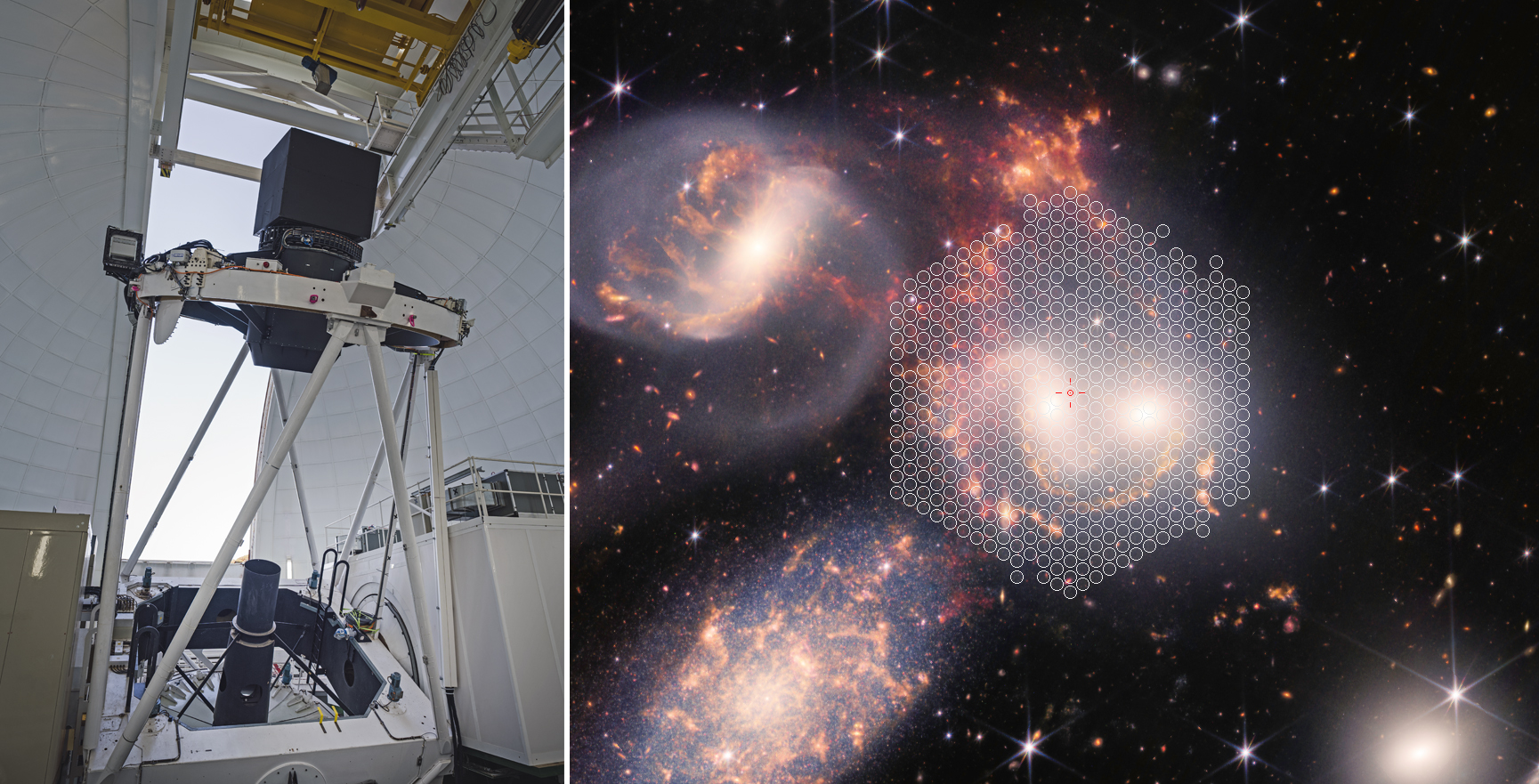
Left: The William Herschel Telescope with WEAVE. The WEAVE positioner is housed in the 1.8-metre black box above the top-end ring. Optical fibres run along the telescope structure to the light-gray enclosure on the left which houses the WEAVE spectrograph. Credit: Sebastian Kramer. Right: The JWST image with the WEAVE LIFU pointing at Stephan's Quintet for the first-light observation. The LIFU gathers light from 547 points on the sky for analysis by the WEAVE spectrograph (each circle indicates an optical fibre 2.6 arcseconds in diameter). The observation provides physical information from each separate region of each galaxy as well as the space in between. Credits: NASA, ESA, CSA, STScI (background image); Aladin (overlay with fibres).
WEAVE, A STATE-OF-THE-ART SPECTROGRAPH
WEAVE is a multi-mode, multi-fibre spectrograph built by a consortium of European astronomical institutions, led by the UK's Science and Technology Facilities Council, to become the next generation spectroscopic facility for the WHT.
WEAVE uses optical fibres to collect light from celestial sources and transmits it to a two-armed spectrograph. The spectrograph separates the light into its different wavelengths, or colours, and records them on large-format CCD light detectors. WEAVE's versatility is one of its greatest strengths. While the LIFU mode houses 547 tightly packed fibres to image large areas of the sky, in MOS mode up to 960 individual fibres can be placed separately using two robots to capture the light from many hundreds of stars, galaxies or quasars. In mIFU mode, the fibres are organised into 20 units, each consisting of 37 fibres, which are used to study small and large targets, such as nebulae and distant galaxies.
WEAVE also provides velocities along the line of sight through the Doppler effect. Depending on the science target, there is a choice between two spectral resolution powers: at low resolution, the spectra distinguish velocity differences of about 5 kilometres per second, and at high resolution of 1.2 kilometres per second. Even at its lowest power of resolution, WEAVE records the line-of-sight velocities of stars with accuracies similar to those of the transverse velocities measured by ESA's Gaia satellite.
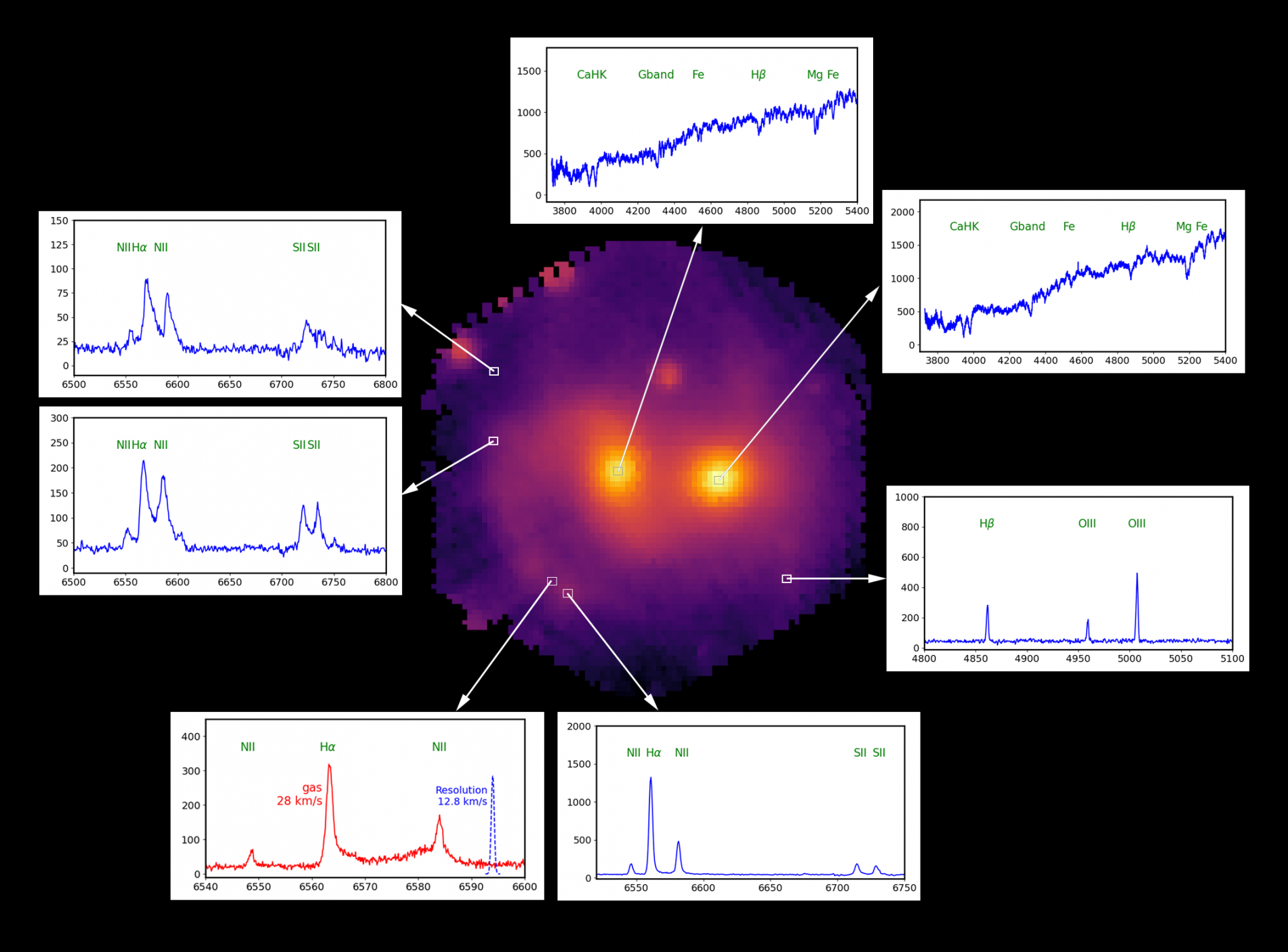
The advantage of the LIFU comes from the sheer amount of information contained in each observation. WEAVE produces spectra for each of 31,500 points or regions in and around the galaxies in two hours. The intensity of light from the fibres builds the image of the galaxies shown in the centre. The individual spectra (intensity at each wavelength; seven examples shown) provide a wealth of information about the physical conditions at each location. At the two galaxy nuclei (top-right) the spectra indicate moderately-old stars (one billion years) and no on-going star formation. The narrow, peaked spectra in the lower-right are typical of gas (hydrogen, oxygen, nitrogen, sulfur) heated to over 10,000 degrees by very young stars, whereas the broad, asymmetric peaks in the spectra shown on the left indicate turbulent shocks between gas clouds. WEAVE is particularly accurate at measuring wavelengths, or velocities. In the bottom-left panel (in red) obtained in the high spectral resolving power mode, velocity distributions as narrow as 12.8 km/s can be measured.
SCIENCE WITH WEAVE
Over the next five years, the ING will devote 70% of the time available at the WHT to eight large surveys with WEAVE, selected from those proposed by the astronomical communities of the partner countries. All of these surveys require spectra of up to millions of individual stars and galaxies, a goal made possible by WEAVE's ability to observe nearly a thousand objects at a time.
These surveys cover studies of stellar evolution, Milky Way science, galaxy evolution and cosmology. In synergy with the European Space Agency's Gaia satellite, WEAVE's MOS mode will be used to obtain spectra of several million stars in the disc and halo of our host galaxy, enabling the development of Milky Way archaeology. Nearby and distant galaxies, some detected by the LOFAR radiotelescope, will be studied for their growth history. And quasars will be used as beacons to map the spatial distribution and interaction of gas and galaxies when the universe was only about 20% of its present age.
The ING will also make 30% of the time available for projects competitively selected from among those proposed by astronomers in ING partner countries. These projects will take advantage of WEAVE's versatility to provide quick answers to immediate questions. There are also channels for programmes that jointly exploit WEAVE and the diverse capabilities of the telescopes of the Canary Islands Observatories such as the 10.4 metre Gran Telescopio Canarias.
WEAVE's construction has been funded by the Science and Technology Facilities Council (STFC, UK), the Netherlands Research School for Astronomy (NOVA, NL), the Dutch Science Foundation (NWO, NL), the Isaac Newton Group of Telescope (ING, UK/NL/ES), the Astrophysical Institute of the Canaries (IAC, ES), the Ministry of Economy and Competitiveness (MINECO, ES), the Ministry of Science and Innovation (MCI), the European Regional Development Fund (ERDF), the National Institute for Astrophysics (INAF, IT), the French National Centre for Scientific Research (CNRS, FR), Paris Observatory – University of Paris Science and Letters (FR), Besançon Observatory (FR), Region île de France (FR), Region Franche-Comté (FR), Instituto Nacional de Astrofísica, Óptica y Electrónica (INAOE, MX), National Council for Science and Technology (CONACYT, MX), Lund Observatory (SE), Uppsala University (SE), the Leibniz Institute AIP (DE), Max-Planck Institute for Astronomy (MPIA, DE), University of Pennsylvania (US), and Konkoly Observatory (HU).
Reference:
Reference:
Shoko Jin et al., 2022, "The wide-field, multiplexed, spectroscopic facility WEAVE: Survey design, overview, and simulated implementation", MNRAS, accepted for publication. http://arxiv.org/abs/2212.03981
Aug 27, 2021 | All, Science
27th August 2021 – The IAA-CSIC heads one of the eleven articles that make up a special issue of the journal Astronomy & Astrophysics on the results of LOFAR
After almost a decade of work, an international scientific team has published the most detailed images ever obtained of galaxies, which provide information about their internal workings in unprecedented detail. The images were created from data collected by LOFAR (Low Frequency Array), a network of more than 70,000 small antennas distributed throughout Europe. The images and the associated scientific results have been published in a special issue of the journal Astronomy & Astrophysics, one of them headed by the Institute of Astrophysics of Andalusia (IAA-CSIC).
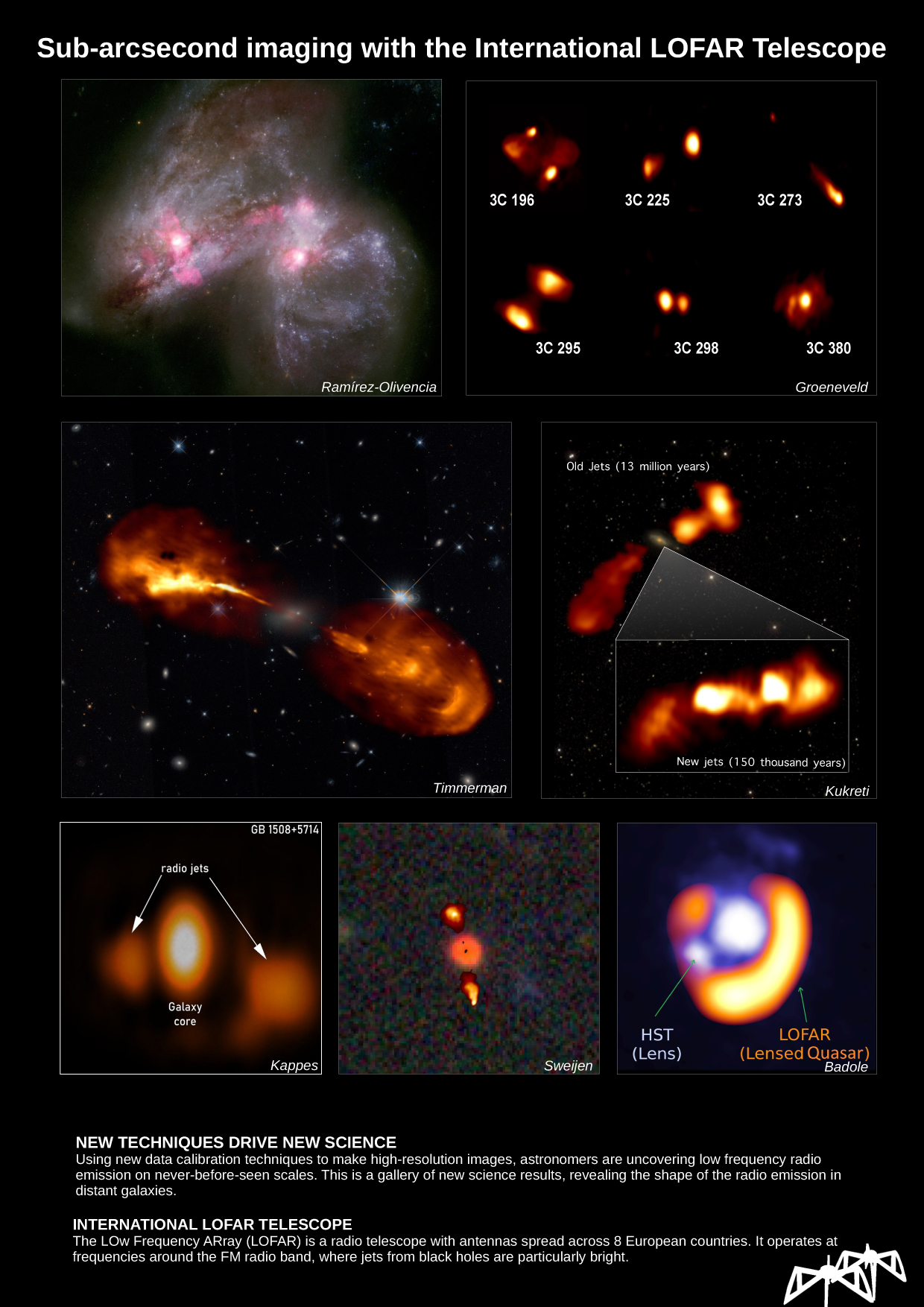
A compilation of the science results. Credit from left to right starting at the top: N. Ramírez-Olivencia et al. [radio]; NASA, ESA, the Hubble Heritage Team (STScI/AURA)-ESA/Hubble Collaboration and A. Evans (University of Virginia, Charlottesville/NRAO/Stony Brook University), edited by R. Cumming [optical], C. Groeneveld, R. Timmerman; LOFAR & Hubble Space Telescope,. Kukreti; LOFAR & Sloan Digital Sky Survey, A. Kappes, F. Sweijen; LOFAR & DESI Legacy Imaging Survey, S. Badole; NASA, ESA & L. Calcada, Graphics: W.L. Williams.
The universe is flooded with electromagnetic radiation, of which visible light, the one captured by our eyes, is only a small portion. From short wavelengths, like gamma rays and X-rays, to long wavelengths, like radio, each part of the spectrum of light reveals something unique about the universe.
The LOFAR network captures images at radio frequencies that, unlike shorter wavelength sources such as visible light, are not blocked by clouds of dust and gas that can obscure astronomical objects. Thus, regions of the sky that appear dark to our eyes glow brightly in radio waves, and radio telescopes allow us to observe areas obscured by dust, such as regions where stars form or the heart of galaxies.
The new images obtained with the LOFAR network go beyond the limits of what we know about galaxies and supermassive black holes. The images reveal the inner workings of both nearby and distant galaxies with a resolution twenty times sharper than typical LOFAR images, made possible by the unique way the team made use of the network.

This image shows real radio galaxies from Morabito et al. (2021). The gif fades from the standard resolution to the high resolution, showing the detail we can see by using the new techniques. Credit: L.K. Morabito; LOFAR Surveys KSP
The more than 70,000 LOFAR antennas are spread across Europe, with the majority in the Netherlands. In standard operation, only signals from antennas located in the Netherlands are combined and a virtual telescope is created with a collecting surface of about 120 kilometers in diameter. By using signals from all European antennas, the team has increased the diameter of the "lens" to nearly two thousand kilometers, providing a twenty-fold increase in resolution.
Furthermore, unlike conventional array antennas that combine multiple signals in real time to produce images, LOFAR uses a new concept in which the signals collected by each antenna are digitized, transported to the central processor, and then combined to create an image. Each LOFAR image is the result of combining the signals of more than 70,000 antennas, which makes its extraordinary resolution possible.
A CHALLENGE OF A DECADE
Even before LOFAR began operating in 2012, the European scientific team began to work on the colossal challenge of combining the signals of more than 70,000 antennas located at a distance of up to two thousand kilometers. "Our goal is that our work allows the international scientific community to use the entire European network of LOFAR telescopes for their own science, and to create high-resolution images with relative ease without having to spend years acquiring the knowledge," says Leah Morabito, researcher at Durham University who has coordinated the work.
The LOFAR results provide new perspectives on known galaxies, show their structure in detail and allow the detection of jets and ejections of material emerging from supermassive black holes in galactic nuclei. Specifically, the Institute of Astrophysics of Andalusia (IAA-CSIC) has contributed with a study of the galaxy Arp-299, which stands out for its high rate of supernova production, or explosions produced by the death of stars with more than eight times the mass of the Sun.
"At the IAA we have been investigating this galaxy for years, which due to the interaction with the companion galaxy is generating outbreaks of star formation -says Naím Ramírez-Olivencia, IAA researcher who heads the study-. It is, therefore, a very interesting object because it allows us to study in almost real time how stars are born, die and interact with the surrounding environment ".
"Our work has been chosen for this compendium of articles related to LOFAR because it is one of the first to show the capabilities of this wonderful instrument for low radio frequencies. Thanks to LOFAR we have managed to detect, for example, a gas outflow emanating from one of the nuclei of the Arp299 galaxy system, and with a scale comparable to the galaxy from which it emanates. Such a result has only been possible thanks to the great sensitivity and resolution of LOFAR, which in its current configuration constitutes a milestone in the astronomy and opens up a world of new discoveries", concludes the researcher.
Reference:
Jul 15, 2021 | All, Science
15th July 2021 – Its abundance in neutral hydrogen suggests that it is a group of galaxies in the process of formation
Most galaxies with intense star formation are contained within a cloud of cold neutral hydrogen, which acts as the fuel from which new stars will form. It is a diffuse, extremely faint gas that can only be detected at radio wavelengths and extends beyond the visible region of the galaxy. The observation of this gas allows us to understand the evolutionary processes that take place in galaxies, and a scientific team with the participation of the Institute of Astrophysics of Andalusia (IAA-CSIC) has found, with the MeerKAT radiotelescope, an ideal object of study: the group of galaxies richest in neutral hydrogen known.
"The distribution of neutral hydrogen in these galaxies has revealed interesting perturbed morphologies that suggest that the galaxies in the group influence each other. For example, we found a pair of interacting galaxies that will potentially merge to form a new galaxy with a completely transformed appearance", says Shilpa Ranchod, a researcher at the University of Pretoria who leads the study.
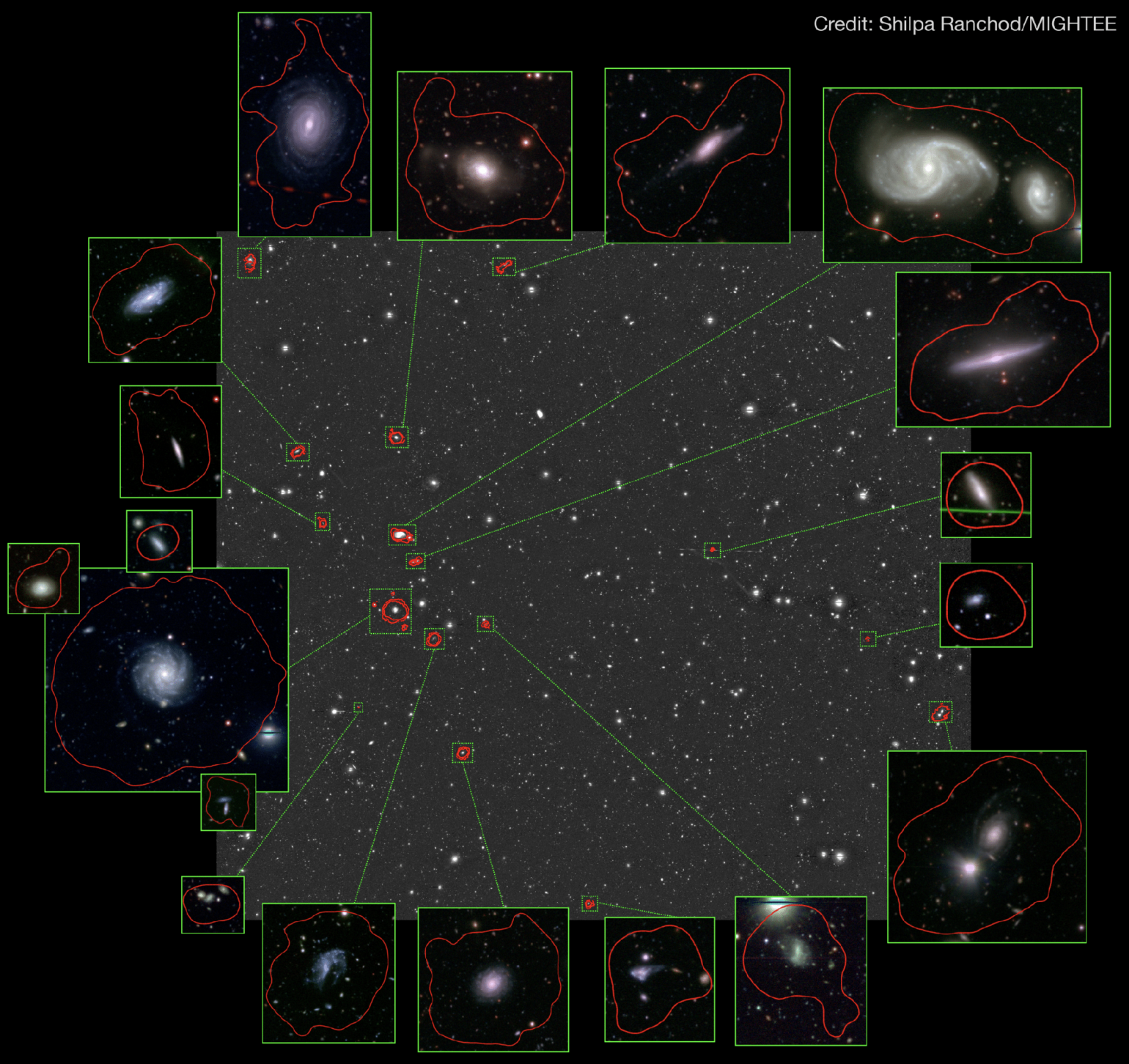
Image of the galaxy cluster with three-color optical images of each member galaxy using data from the Hyper-Suprime camera on the Subaru telescope. The red outline indicates the extent of neutral hydrogen around each galaxy. Credit: Shilpa Ranchod / Project MIGHTEE / HSC.
The discovery is part of the MIGHTEE (MeerKAT International Gigahertz Tiered Extragalactic Exploration) legacy project, one of the major surveys being developed with the MeerKAT telescope (South Africa) and involving an international science team. MeerKAT is the South African precursor to the Square Kilometre Array (SKA), which will be the largest scientific infrastructure on the planet, and aims to answer fundamental questions about the formation and evolution of galaxies. Its exceptional sensitivity provides a better understanding of the drivers of galaxy evolution.
This new group of galaxies lies in an area of the sky that has been studied in depth with other radiotelescopes, but only with MeerKAT has it been possible to observe the structure of the group so clearly. The environment of galaxies greatly affects how galaxies grow and evolve, and observations of neutral hydrogen with MeerKAT offer a new window into these structures.
"This is just a preview of what the MeeeKAT legacy project MIGHTEE will show us, and of the discoveries we will make with the SKA. This is a case of special interest for the line of research I coordinate at the IAA: unlike the dense groups of galaxies with a high deficiency in atomic gas with which we usually work and which, as we proposed, would be more evolved, in this case, a lot of gas has been detected, which suggests that we are dealing with a group in an early evolutionary phase, that is, a group in formation", says Lourdes Verdes-Montenegro, a researcher at the IAA who is participating in the study and coordinating the Spanish participation in the SKA.
This discovery will help to lay new foundations for understanding how galaxies assemble into groups and transform themselves through interaction with their environment. MeerKAT is an important step in the direction of the SKA, providing insight into future scientific projects and examples of how to overcome the many technical challenges involved in its full scientific potential.
Reference:
Reference:
S. Ranchod et al. "MIGHTEE-HI: Discovery of an HI-rich galaxy group at z = 0.044 with MeerKAT". Monthly Notices of the Royal Astronomical Society, July 2021. https://arxiv.org/abs/2107.01237
Nov 30, 2020 | All, Science
30th November 2020 – MHONGOOSE, a legacy project of the MeerKAT radiointerferometer, South African precursor to the Square Kilometer Array, produces its first results. They have been obtained in its preparatory phase, thus anticipating the window that will open to the understanding of the formation and evolution of galaxies.
MHONGOOSE (MeerKAT Observations of Nearby Galactic Objects - Observing Southern Emitters) is a legacy project to study the distribution of atomic hydrogen (HI) in a selection of nearby galaxies using the MeerKAT radiotelescope (South Africa). As part of its testing phase, it has already provided its first scientific results. This first work, published in the journal Astronomy and Astrophysics, provides new findings on the distribution of gas around the galaxy ESO 302-G014 and shows the potential of the project.

Aerial view of the MeerKAT interferometer under construction. Credit: SARAO.
MHONGOOSE will study how galaxies capture gas from their surroundings and the relationship between gas and star formation. To do so, the distribution of atomic hydrogen (HI) will be studied in a sample of 30 nearby galaxies, located less than 65 million light years from our Milky Way. The galaxies have been selected to cover all inclinations, from edge-on galaxies to front-on galaxies, and cover a very wide range in mass and luminosity.
This variety in the sample allows addressing various questions about the transformation and evolution processes of galaxies in the nearby universe. The project has obtained 1650 hours of observation in the MeerKAT radiointerferometer, a precursor of SKA (Square Kilometer Array) consisting of 64 antennas located in the Karoo desert, in South Africa. MeerKAT is, until SKA is built, the most efficient telescope to obtain the type of data that is needed in MHONGOOSE.
Gas Clouds Surrounding a Dwarf Galaxy in the Southern Hemisphere
The first results that MHONGOOSE provides correspond to the galaxy called ESO 302-G014, a nearby gas-rich dwarf galaxy. The international scientific team responsible for the work, which has the participation of the IAA-CSIC, has used observations made with MeerKAT, together with complementary data in other wavelengths, to study its evolutionary history. They have found that the galaxy has a thin, asymmetrical outer disk, as well as a tidal tail of atomic hydrogen and an isolated cloud about 6,500 light-years from this galaxy.
These structures, which had not been previously detected, seem to indicate that the galaxy underwent an interaction with another low mass galaxy. Lourdes Verdes-Montenegro, IAA-CSIC scientific researcher and the only Spanish member of the MHONGOOSE team, highlights that “the detected signs of a possible interaction with some low-mass galaxy companion are also supported by the presence of significant amounts of molecular gas detected by the ALMA interferometer and the existence of prominent star clusters, suggesting a recently induced star formation”.
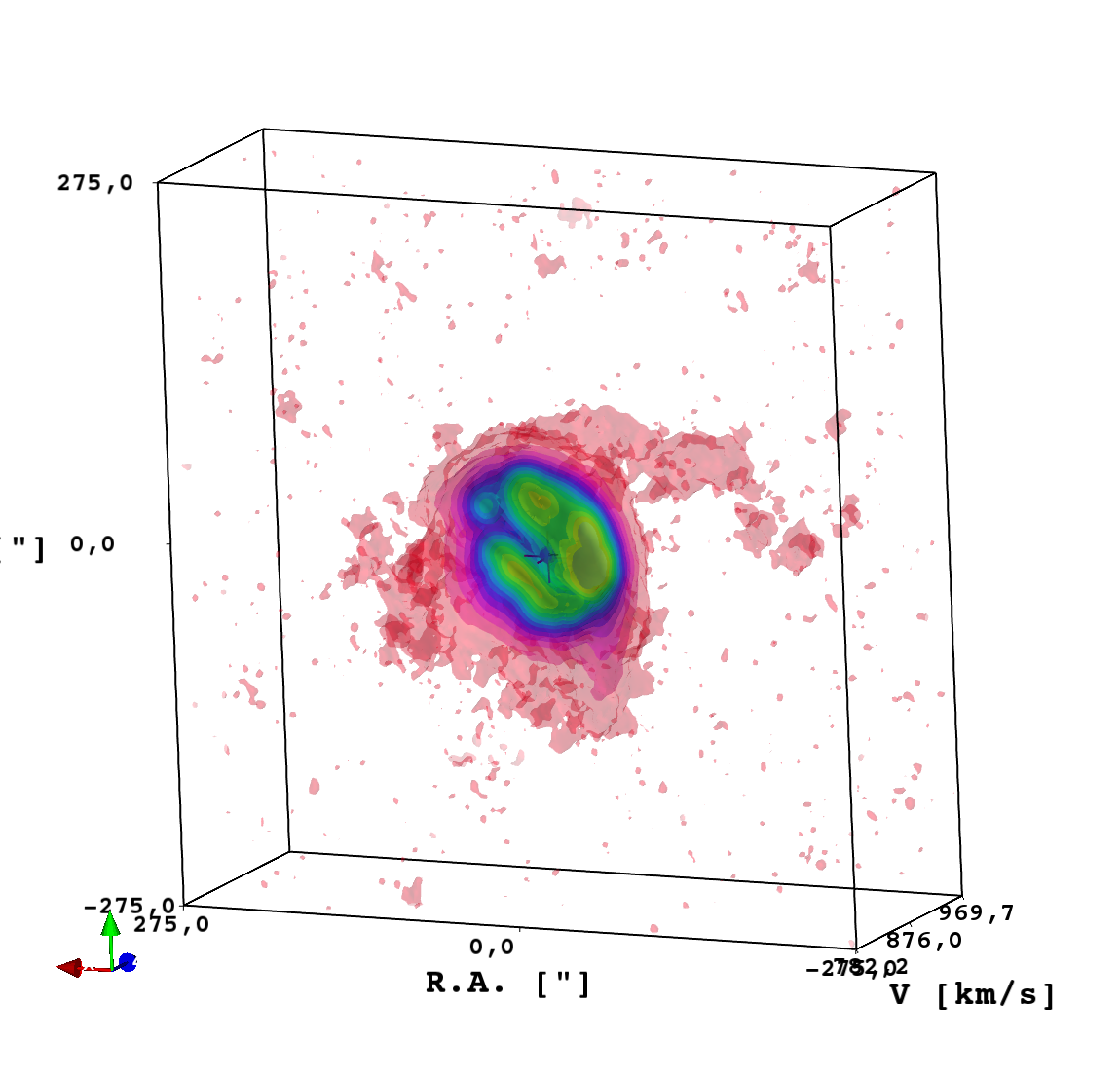
Emission of atomic hydrogen associated with the galaxy ESO 302-G014, represented in three dimensions, where the structure that could correspond to a possible interaction with a low-mass companion is shown. Credit: Lourdes Verdes-Montenegro (IAA-CSIC).
"The deep images from the Dark Energy Camera Legacy Survey show a faint and diffuse object near the end of the filament, whose radius, brightness and color are compatible with that of a dwarf galaxy at a distance similar to that of ESO 302-G014", points out Javier Román, a researcher at the IAA-CSIC expert in deep optical images who participates in the work.
These results are, according to Lourdes Verdes-Montenegro, “just a small preview of things to come”, as they have been obtained with preliminary observations, and she is confident that “in-depth observations of the objects in the MHONGOOSE sample will offer a glimpse of the fate of atomic gas when transferring from the intergalactic medium to galaxies”. In the medium-term future, these types of observations will be able to be extended to more distant galaxies thanks to SKA, which will be the largest radiotelescope in the world, and in which MeerKAT will be integrated to form a single interferometer.
Reference:
Jul 21, 2016 | All, Science, SKA-spain
Bilbao, 19 de julio de 2016 – El Square Kilometre Array (SKA), que será el mayor radiotelescopio del mundo y cuenta con gran involucración de la comunidad astronómica española, ha protagonizado una de las sesiones plenarias de esta reunión científica que se celebra anualmente en España.
La XII Reunión Científica de la Sociedad Española de Astronomía que se celebra estos días en Bilbao tiene en la instrumentación del futuro para la observación astronómica uno de los temas principales, con especial énfasis en la participación científica y tecnológica española. En concreto en el SKA, que una vez construido será el radiotelescopio más sensible del mundo.
En la sesión plenaria sobre el SKA han participado Philip Diamond, Director General de la Organización del SKA que lidera el proyecto; Lourdes Verdes-Montenegro, investigadora del Instituto de Astrofísica de Andalucía (IAA-CSIC) y coordinadora de la participación de España en el SKA; el investigador del Instituto de Física de Cantabria (IFCA-CSIC), Diego Herranz, y los investigadores del IAA-CSIC Ivan Agudo, Miguel Ángel Pérez Torres y Guillem Anglada.
Phil Diamond, Director General de la SKA Organisation ha sido invitado a la Sesión Plenaria del SKA en el XII encuentro bienal de la Sociedad Española de Astronomía, celebrada en Bilbao el 19 de julio de 2016. En dicha sesión dio una charla acerca del estatus actual del proyecto SKA.
Un proyecto de vanguardia
El Square Kilometre Array (SKA) será la mayor infraestructura científica construida sobre la Tierra. SKA es un conjunto de cientos de miles de antenas que se instalará en Sudáfrica y Australia –está previsto que la construcción comience en 2018– y será el radiotelescopio más sensible jamás construido, lo que supone un enorme reto tecnológico que abrirá las puertas a nuevos descubrimientos científicos. Entre ellos destacan el estudio de las primeras etapas del universo y la formación de las primeras estrellas, la física de los púlsares y de las ondas gravitacionales, la naturaleza de la materia y energía oscuras, y la búsqueda de vida en otros planetas a través de trazas moleculares y de potenciales inteligencias extraterrestres a través de señales de radio, según ha expuesto el profesor Philip Diamond, Director General de la Organización SKA que lidera el proyecto.
Participación española en SKA
La participación de España en actividades relativas al SKA se inició en la década de 1990 y “desde 2012 las actividades se han intensificado, bajo la coordinación del Instituto de Astrofísica de Andalucía (IAA-CSIC). Actualmente 21 investigadores de 8 centros españoles diferentes participan en 7 de los 11 Grupos de trabajo científicos de SKA. En el ámbito tecnológico, participan más de 20 centros de investigación y empresas de tecnología españolas”, ha señalado Lourdes Verdes-Montenegro, investigadora del Instituto de Astrofísica de Andalucía (IAA-CSIC) y coordinadora de la participación de España en el SKA.
“Científicos e ingenieros españoles vienen trabajando fuertemente para conseguir posicionar estratégicamente a nuestro país y lograr el máximo retorno científico del SKA, así como para contribuir en paquetes de trabajo de relevancia tecnológica y alto potencial de innovación. Este esfuerzo podría ser aprovechado si España se convierte en miembro de pleno derecho antes de que comience la construcción de la que será la mayor infraestructura científica sobre la Tierra”, ha destacado Lourdes Verdes-Montenegro. Actualmente la Organización del SKA está formada por diez países: Australia, Canadá, China, India, Italia, Nueva Zelanda, Sudáfrica, Suecia, Países Bajos y Reino Unido, siendo España país Observador.
La ciencia y la tecnología que están por venir
“Muchas de las incógnitas aún no resueltas de la cosmología moderna, tales como la naturaleza de la materia y la energía oscura, que dominan la dinámica del Universo, podrán ser estudiadas en profundidad por el SKA”, ha expuesto Diego Herranz (IFCA-CSIC) en su conferencia Amanecer cósmico, época de reionización y sinergias con radiación de Fondo Cósmico de Microondas . Ha afirmado también que “la comunidad astronómica española tiene un gran interés en participar activamente en el desarrollo de la ciencia que se lleve a cabo con el SKA, así como la experiencia suficiente para jugar un papel fundamental dentro de este proyecto internacional”.
Iván Agudo (IAA-CSIC) ha centrado su conferencia Núcleos Galácticos Activos en longitudes de ondas de radio en las posibilidades que ofrece el SKA respecto al estudio de los Núcleos Galácticos Activos (AGN en sus siglas en inglés). Agudo explicó que “los AGN son las fuentes de radiación duradera más potentes conocidas hasta ahora. Pueden eclipsar a las galaxias que los albergan y producir, a partir de sus agujeros negros supermasivos centrales, potentes chorros que se alejan a grandes velocidades y que radian enormes cantidades de radiación en todo el espectro electromagnético”. Agudo afirmó que el SKA, gracias a su sensibilidad sin precedentes, permitirá dar un salto de gigante en este campo.
Otra de las novedades que ofrece el SKA, será hacer observaciones simultáneas de porciones del cielo con una capacidad de discernir detalles y una profundidad que no se han conseguido hasta el momento. Miguel Ángel Pérez Torres (IAA-CSIC) expuso en su charla Supernovas y Galaxias cercanas normales y luminosas en el infrarrojo que “las observaciones con SKA darán acceso a un mejor entendimiento de la formación estelar y los procesos de acreción de materia en el Universo cercano, gracias al estudio de un amplio número de galaxias próximas”.
Por último, Guillem Anglada (IAA-CSIC) centró su conferencia Discos protoplanetarios, chorros y el nacimiento de las estrellas en explicar el proceso de formación planetaria que tiene lugar en discos de polvo y gas alrededor de estrellas jóvenes, y cómo el SKA será una herramienta clave al poder hacer observaciones con un detalle sin igual de este tipo de los discos. Aunque los interferómetros VLA y ALMA ya han observado estos discos, el SKA mejorará la resolución espacial de las imágenes, con lo que podremos entender mejor este proceso de formación.
Esta sesión plenaria durante la SEA convocó a un gran número de asistentes, que mostraron su interés por el proyecto SKA.









